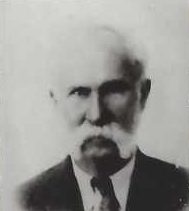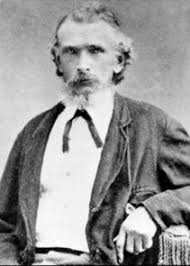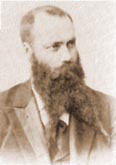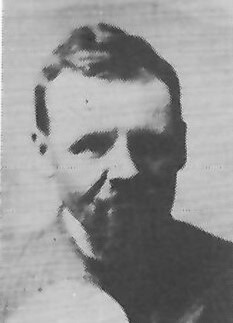As told by John Jerome Whetten in The Whetten Book of Ours.
Today is August 25, 1968. I’m in Providence Memorial
Hospital in El Paso, Texas, being treated for a disc problem in my back. I have
been here for more than a week, so I have had plenty of opportunity to reflect
on the occasion 3 1/2 years ago when my father and I were in two other rooms
just down the hall. My emotions and my thinking are still unsettled when I
think of that day, so I have hesitated to write about it before. There are
things that happened that day and afterwards which are sacred to me and my
family and I would ask any who might read this to please keep this in mind.
When our family first moved down from Chupe, Dad
bought a field in San Diego (titled land) and planted an orchard. He was quick
to help others around him and show them how to make their land produce more
with orchards, more water, machinery, etc. Running these were our neighbors,
the Saenz Family. Dad was well accepted by the people in San Diego and when the
chance came a few years later to acquire some ejido property, our neighbors
were all for it. All agreed that the property could be in my name as I
was a Mexican citizen. All went well for about 15 years, the orchards grew, our
neighbors prospered, and the situation gradually changed. Politics in the ejido
became important and with it an anti ‘gringo’ sentiment. One of the Saenz boy,
Gilberto, decided that if he could claim a ‘parcela’ he would be eligible for a
position in the new ‘ejido ganadero’. He had been to school and acquired
socialist ideas and contacts. As isusual with this type of individual,
the idea of something for nothing dominated his thinking. Since we were
‘anglos’ it was easy for him to promote
the idea that as gringos we had no right to ejido land. We would go to the
authorities, defend our position, disprove their lies and get written orders
for us to continue to use the land we had been using for 15 years.
The Saenz Family contemptuously ignored the
authorities and continued to use a small corner of the land near the river.
(They claimed we were not using it yet they plowed up a crop of corn we had planted.)
This went on for about two years. It was evident that they were not going to
obey the authorities and the authorities would not put them off. This was the
situation on March 13, 1965 when we decided to go plow this comer of land and
let them know that we were not going to be pushed off. I have wasted countless
hours thinking of what we should and shouldn’t have done that day. It is
fruitless to worry about it, nothing can be changed, and of course the Lord is
the judge.
My brother Bert (Albert Kay) drove Hawkins’ tractor and plow to the “Cienega” where we were making a large pond to catch the water from a flowing well that Dad had just drilled. This project was a community project with Dad doing most of the work and putting up most of the cost. Dad and I drove there ahead of Bert in a pickup Bert was using in his work with Uncle Jay. (It was the same pickup Uncle Don had been riding in when he was killed a few months before.) When Bert caught up with us, I took the tractor and Bert came on with Dad. Bert was to bring me back after I had finished, and Dad was going to go over to the orchard to plow for the rest of the day. I was to have an interview at school and Bert had made plans to be with his girl, Alice Mickelsen. Ricardo Quintana had been working with Bert and was with us. The plowing was to take about two hours.
I had been plowing about an hour and a half when Aureliano Saenz came driving up in a pickup. He parked in front of ours, and got out yelling at Dad about gringos being on land that didn’t belong to them, and threatening to go get soldiers. Bert took the keys out of Aureliano’s truck. I continued plowing. About two minutes later, Ramiro Saenz came riding up on a mule and picking a tree limb he started running over to where Dad and Aureliano were arguing. I jumped off the tractor and throwing my jacket off, I started after Ramiro. Ramiro hit Dad on the back of the head with the limb, knocking him to the ground. Almost immediately I caught Ramiro with my right fist on the side of his face. I was on a dead run and the force knocked him back about 15 ft. Blood was streaming down his face and he got up saying, “No more.” Dad seemed to be all right, so I went back to plowing. I had just started when I saw Gilberto running across the field from another direction with a pistol in his hand. As I got off the tractor, Dad said, “They’ve got a gun, so don’t fight with them.” Gilberto picked up a stick and was beginning to fight with Bert. They were going round and round making quite a commotion. I heard a shot (no one else remembers it) and Bert told him to stop, that was enough. Meanwhile Ramiro and Aureliano were beating Dad with a tree limb. Ramiro made a couple of half-hearted attempts to hit me, but didn’t seem too anxious. They got us all three together. As Gilberto brought Bert over I asked, “Did he shoot you Bert?” Bert shook his head. Gilberto said to me, “Why did you hit my brother?” “Because he was hitting Dad.” “Why don’t you tackle me?” “Throw that gun away and I will.” “No, I brought this gun to kill you.”
He pointed the gun at my chest, I turned a quarter tum
by stepping back with my right foot. The bullet went across my chest and hit my
right arm just above the elbow, passing on through
without hitting the bone. It jerked my arm upwards and curled my fingers
backwards. My first thought and sensation was that it had h:: the bone and tore
my arm from the elbow down. I just couldn’t believe that he had actually shot.
As I stared at my arm Dad said, “Did he hit you?” I looked at Dad and
suddenly felt a bullet go through my stomach from left to right. My knees
buckled and as I went down I heard more shooting.
Bert was shot through the heart. He turned and walked the length of the two pickups, said to his friend Ricardo, “Compadre, they’ve got me” and he fell down on the sand. Gilberto shot Dad through the chest, right side. When he went down he was clubbed on the head. He tried to protect his head with his hand and a bone was splintered (compound fracture) just above the 4th knuckle of his right hand. Gilberto stood over him and said, “Now Glen, I’m going to kill you.” He pointed the pistol at his head and pulled the trigger. Dad was still struggling and the bullet missed his head, hit his collarbone, shattered it, and went on down his rib cage, lodging somewhere in his lower chest. They begin to kick us telling us to get up. Dad said, “Can you get up?” I said, “I think so, can you?” He said yes so we got up and started back toward the rear of the trucks. I got to Bert first. There was a bloody foam coming out of his mouth and I thought, “I’ve got to clear his throat.” I dropped by him and attempted to clear his mouth and throat. I felt a faint swallowing reflex and suddenly I sense that he was dead.
Dad came up and I said, “They got Bert.” He said, “Yes, they got Bert.” Everything was unreal. We didn’t sense the tragedy of it at all. That didn’t come to me for several days. It was just all matter-of-fact. My sensation was just the senselessness of all of it. “How stupid, how unreasonable” I kept thinking. I was feeling quite strong so I thought, “I’ll turn the pickup around and I think we can get out of here.” I got into the truck, but no keys. I got back out, I was beginning to get a terrible pain in my side where the bullet had gone through my liver. I thought, “If I get into the back of the truck they won’t have to put me in.” I got in the back and laid down but the pain was so intense that I couldn’t lie still on the hard bed. As I got back out I realized I was getting weak and might faint. The thought came to me, “You’ve got to stop moving around, and lie still.” I laid down on the sand next to Dad and Bert. Dad asked me where I was shot, I told him and he said, “We’ll all die.” He turned on his side away from me curled up a little and said, “Everything is going black. I’m dying.” I reached up and put my hands on his head. He protested saying, “No, leave me alone.” I said, “Brother Glen Whetten, by the authority of the Holy Priesthood I command you to remain alive until help can reach you, if it be the Lord’s will, in the name of Jesus Christ, Amen.” The effect was electric.
Dad said afterwards he felt strength
flow all through him. He quickly turned over with an eagerness in his voice, he
said, “Here let me give you the same blessing. Everything changed. Instead
of the devilish, evil atmosphere, there was a calm feeling that gave us the
strength to resist the pain. Gilberto
noticed the change too. He had been gloating over what he had done saying such
things as, “Take them away where they’ll die quickly. Why aren’t they dead
yet.” Suddenly he felt nervous. Aureliano handed him something, whispered
something to him and he took off across the field on a run Aureliano came over
and said, “OK Glen, now will you recognize me as the authority?” Dad
answered, “Aureliano, is this field worth three lives?”
“Yes, “Cabron” and three more too.”
(I’ve wondered a lot about that remark.) By this time several Mexicans had
arrived. Tomas Acosta came running up and asked Dad what was wrong. “Help us, Tomas” Dad said. “Get
us out of here.” “Si, como no.” (Yes, of course) and he took charge
of the situation, turned the truck around and in spite of the Saenz brother’s
protest they loaded Dad and I into the back of the pickup, leaving Bert where he was. Ricardo drove (Bert
had just been teaching him to drive). Tomas was in front also, and Jose
Gonzalez was in the back with Dad and me. Dad was laying on his side away from me so he kept asking me if I was all right. I felt strong enough but the pain
was so intense I had to force myself to speak. The six miles home seemed just
too far.
Dad kept saying, I’ve killed my boys.” I kept
assuring him I was all right, but tragedy of what had happened was beginning to
get through to him. When we got to town the Mexicans wondered if we wanted to
go home. “No” I said, “Take us to Ernestine.” I wondered
why I had to do their thinking for them. A little later I thought Ernestine was going to take us to Casas in the
back of the pickup and I began to wonder if anyone was rational. This of course
wasn’t the case, and we were soon headed
for Casas in Ernestine’s station wagon.
At the hospital they gave me something for the pain
and I began to relax. Louise and Mother came in. I had began to vomit blood and
I soon lost track of what was going on. The missionaries were there and
administered to us. Some say I very nearly died there in Nuevo Casas Grandes.
Bishop Romney told me that he and Bro Taylor administered to me. It calmed me
down and then I held onto them and insisted that they stay near. There was a
debate going on as to whether we would survive a trip to El Paso. When they
typed my blood, Bro. Edwin McClellan recognized it as the same as his, and
immediately volunteered to give me some. Soon after they began the blood
transfusion, I became aware of my surroundings again.
It was decided that Oswaldo Avena would fly me out (a doctor with us), and Ted Farnsworth would fly Dad out (Ernestine with him). As they wheeled me out of the hospital room, Uncle Bert (James E. Whetten) gave me a blessing. He promised me that I would make the trip all right and that I would recover. He was one of several who received a definite assurance that I would recover. Others who received this same impression included my wife, Louise, Grandma Durtchie, Dan Taylor, my brother Bob, and myself. I really never thought otherwise, and I was surprised and impatient with people that thought I seriously ill.
) gave me a blessing. He promised me that I would make the trip all right and that I would recover. He was one of several who received a definite assurance that I would recover. Others who received this same impression included my wife, Louise, Grandma Durtchie, Dan Taylor, my brother Bob, and myself. I really never thought otherwise, and I was surprised and impatient with people that thought I seriously ill.
There were many people helping in so many ways, that
it would be impossible to give credit to each. There were legal arrangements,
Bert had to be brought up from San Diego. The airplanes had to be made ready.
Relatives notified, advance arrangements in El Paso, etc. The support and unity
shown by our friends was simply overwhelming.
Oscar Bluth helped me into the airplane, there wasn’t
room for me to straighten out completely. My head was against the wheel next to
the pilot, and I had to double my knees. The doctor sat on the floor behind the
pilot. Louise came over to tell me goodbye. I was disappointed, I had thought
she would be going with me. I continued to vomit blood on the way out. The
smell was terrible inside the small plane. I wondered to myself how long it
would last. The doctor told the pilot to get as low as possible so we skimmed
the mesquites. Oswaldo would look at me
and say, “Ay, que Juanita.” (We had flown together before). I think
of the container of blood hanging over me with the ‘O Pos’ written on it. Bro.
McClellan’s blood, probably saving my life, and then two years later I helped
put him on the same airplane with the same pilot for the same trip to El Paso,
only he didn’t survive the trip. I truly lost a great friend.
There was an ambulance waiting for me at the Juarez airport. We made a quick trip through Juarez, the border officials were very considerate, and I must confess, I felt quite important going through downtown El Paso with the siren screaming. At the hospital, Dr. Wilcox was ready for me. They stopped only long enough for a quick X-ray, cut my clothes off, and then into the operating room. As we turned a corner in the corridor, there was Betty Evans, my cousin, to greet me as I went by. I was glad she was there. Someone was concerned about which faith I belonged to (I suppose they thought I needed some last rites) when I said ‘Mormon’ they simply hurried me on.
The next I remember, I was protesting that I didn’t
need the catheter. Ernestine heard me and came over. She told me that Dad was
there and probably wouldn’t need an operation, that my operation was a success,
she told me briefly what they had sewed up inside me and assured me that I was
going to be alright. I was disappointed that Louise wasn’t there yet, and
somehow I got the idea that she wasn’t coming.
Ernestine told me later that when she walked into the
operating room, she was glad to see I had the best surgeon and the best anesthesiologist
in El Paso. The doctor later told me that somehow the bullet had missed my
spleen, made two holes in my large colon, came very close to the aorta, cut my
pancreas about a third of the way through, made four holes in my stomach, gone
through my gall bladder, and a small part of my liver. The slug had lodged just
under my skin on the right side. He said there was a lot of material to clean
out of my abdomen. He made two openings
for drains, and another for a tube leading out of my gall bladder. He said that
first he stitched the gall bladder closed then decided against it and cut the
stitches and put in the rubber tube.
In talking with Dr. Wilcox later, he told me that he
had a hunch I was going to make it. In his visits he always radiated confidence
and optimism, whereas his partner. Dr. Harris, didn’t. Dr. Wilcox later told
Dr. Hatch that when he saw me he didn’t think I would get through the operation,
then he thought secondary shock would get me and peritonitis would set in if I
survived that long. Dr. Harris later told me that the only statistics they
could find were battlefield statistics, and that with that many organs hurt,
there just wasn’t any percentage of survival. But the hand of the Lord is in
all things and I had been promised that I would recover.
When I woke up after the operation in the intensive
care unit, Louise was there. She told me that Bro. and Sis. Mennell Taylor had brought
her out; that as they came through Casas Grandes she saw a plane land and asked
them to stop. Her mother and father were on the plane. They had come from
Cananea. They got in with the Taylors and came on out to El Paso with Louise. I
also found that Aunt Mae and Uncle Buzz were there from Odessa. These people were
a real source of strength to us (Dad was right across the hall).
Many people came by. Some I didn’t remember their visits but found out later they had come. Dad and I have marveled many times since at the tremendous rally of love, help, and the sweet spirit that so contrasted the evil, devilish scene we had witnessed earlier. Bert’s missionary President, Pres. Harold Turley and his wife came to see me. There were tears in their eyes as they spoke of Bert.
During the second day, Bert came to see me. I turned
to see who had come into the room and he was standing by the bed. I couldn’t
see anyone, yet I immediately recognized who it was, and I said to myself,
“Oh, it’s Bert.” This did not seem unusual to me at all.
At about this time, Glen, Amy, Harvey, Velma, and I think Clifford arrived from Provo. I was glad to see them, I was glad Dad could visit with them (Dad was having a tough time. He felt that he had not been warned or had not recognized the warning that would have prevented us going to San Diego that day. Dad has always been able to sense trouble, and the wrong course of action, yet that day there was no indication of trouble or any hesitation on the part of either me or my father about going). I knew Mother would be happy to have them home. I was worried about how she was holding up. Bob, Amanda, and Neil had missed connections and were farther back up the road. When they arrived, Adrian Wagner flew them to Colonia Juarez so they were able to be there for the funeral. I am sure my Mother must have had a lot of spiritual help to meet what she had to face. The only word from Dad and I in El Paso was, “As good as can be expected.”




